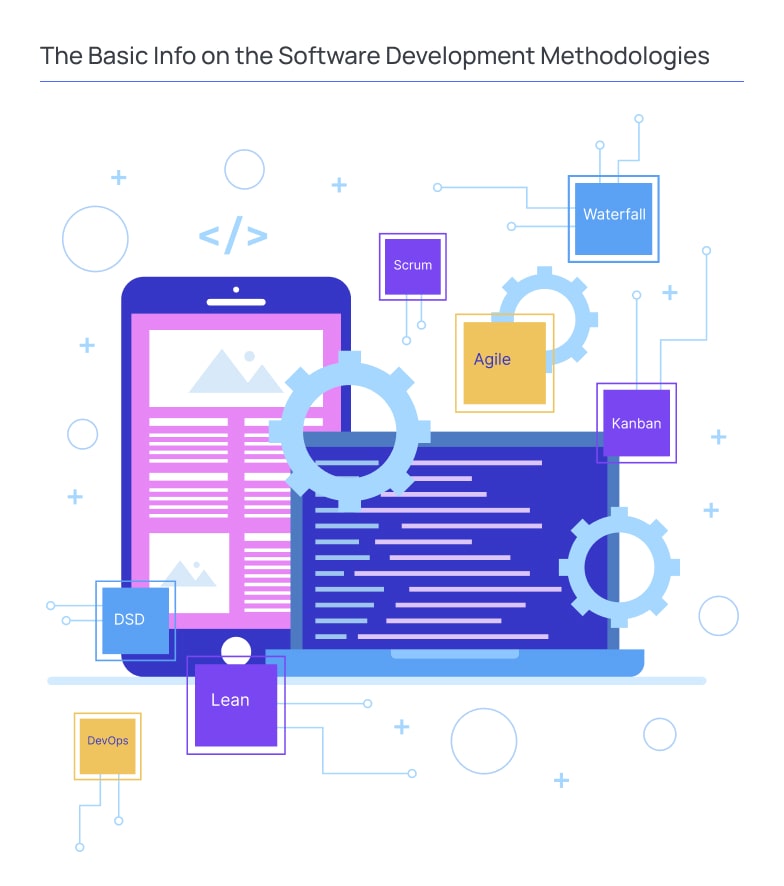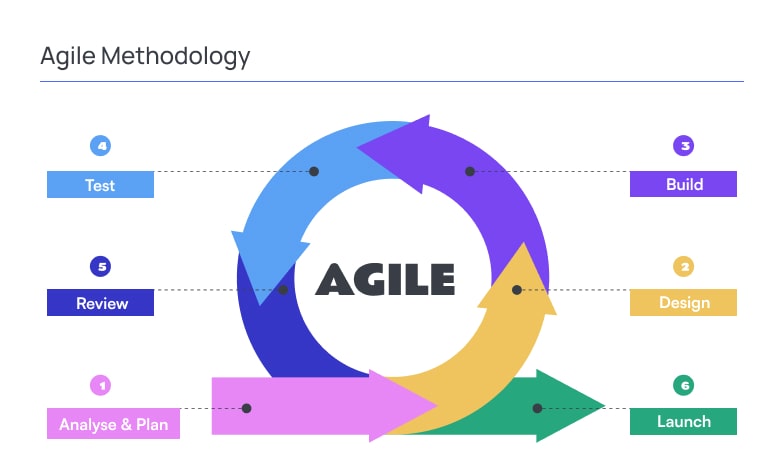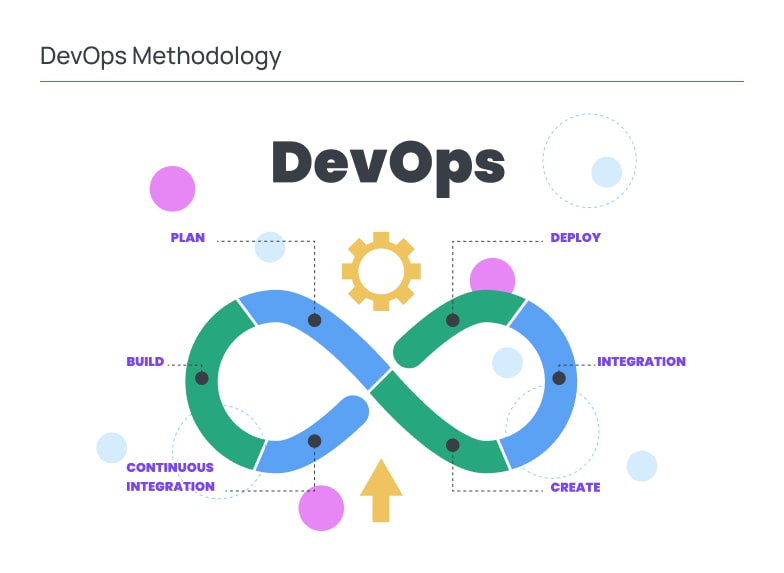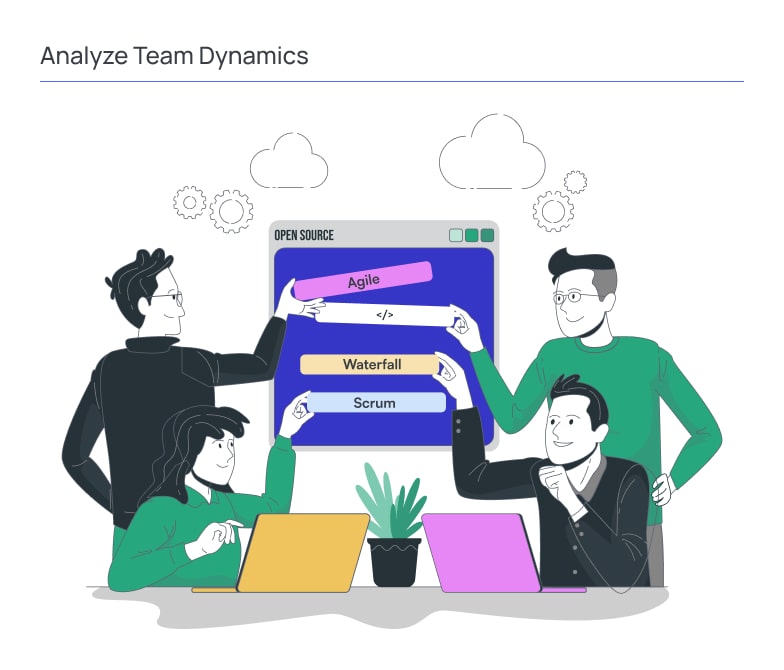Without a clear plan, you’d be navigating through uncharted territory with no roadmap, leading to chaos, missed deadlines, and costly mistakes. This is where software development methodologies step in. They offer a well-defined path to follow, ensuring that software projects stay on track, within budget, and meet the desired quality standards.

What Is Software Development Methodology
Software development methodologies are the guiding principles, practices, and processes that shape the way software is designed, built, and delivered. These methodologies are essential in ensuring that software projects are well-organized, efficient, and result in high-quality software products.
Imagine you’re embarking on a journey to build a complex piece of software.
Let’s explore some of the most popular software development methodologies in detail and understand their advantages and drawbacks.
Types of Software Development Methodologies: The Most Popular Ones
Software development methodologies span a spectrum of approaches, each suited to specific project requirements, team dynamics, and organizational goals. Let’s take a closer look at the list of software development methodologies we’ve compiled:
Waterfall Methodology
The Waterfall methodology is a traditional, linear approach to software development. It consists of distinct phases that are executed sequentially, with each phase building upon the outputs of the previous one. The phases typically include requirements gathering, system design, implementation, testing, deployment, and maintenance. Each phase must be completed before the next one begins.
Pros and Cons
Pros:
- Clear and well-structured. The Waterfall model provides a clear structure, making it easy for both the development team and stakeholders to understand the project’s progress.
- Easy to manage and understand. Due to its sequential nature, it’s relatively easy to operate and assess the project’s progress.
- Documentation at each stage. Rigorous documentation is maintained at each phase, ensuring a clear record of project details.
Cons:
- Limited flexibility for changes. The Waterfall model is not suited for projects with evolving requirements, as changes are difficult to accommodate once a phase is completed.
- Long development cycles. The project moves through phases sequentially, which can result in extended development times.
- High risk of scope changes. Stakeholders may realize their requirements have changed after the project is well underway, leading to costly scope changes.
Dynamic Systems Development (DSD)
Dynamic Systems Development (DSD) is an agile software development framework focused on delivering rapid results and adapting to changing requirements. This methodology divides projects into short iterations, typically two to six weeks, with each iteration producing a potentially shippable product increment.
Pros and Cons
Pros:
- Rapid Delivery. DSD’s iterative approach ensures quick delivery of functional increments, providing early value to stakeholders.
- Collaboration. DSD promotes continuous communication and collaboration between teams, stakeholders, and end-users, enhancing project understanding.
- Flexibility. It accommodates changing requirements, making it ideal for projects with evolving scopes.
- Customer-Centric. DSD prioritizes delivering value to the customer by addressing high-priority features early.
Cons:
- Resource Intensive. DSD may require significant stakeholder involvement, which can be resource-intensive.
- Complexity. Frequent changes and iterations can introduce project complexity.
- Documentation. It prioritizes working software over extensive documentation, which may not suit projects requiring strict documentation.
- Stakeholder Availability. Success depends on active stakeholder engagement.
- Scalability. It’s best suited for smaller to medium-sized projects and may face challenges with more extensive, complex endeavors.
Agile Methodology
Agile methodologies are iterative and flexible software development approaches that prioritize collaboration, customer feedback, and the delivery of small, functional increments of software in short cycles. Unlike Waterfall, Agile does not follow a linear path and welcomes changes throughout the development process.

Pros and Cons
Pros:
- Emphasis on customer satisfaction. Agile methodologies focus on delivering value to the customer continuously, ensuring their needs are met.
- Adaptability to changing requirements. Agile can accommodate changing requirements, making it suitable for projects where requirements may evolve.
- Frequent product deliveries. Agile encourages regular releases of functional increments, providing stakeholders with early access to the product.
Cons:
- Requires active customer involvement. Active participation from the customer is crucial for Agile success. If customers are not engaged, the project may suffer.
- Complex to manage for larger projects. Agile can be challenging to manage in larger projects with more significant complexity.
- Lack of comprehensive documentation. Agile prioritizes working software over extensive documentation, which can be a drawback in some regulated environments.
Scrum Methodology
Scrum is a specific Agile framework that organizes work into time-bound iterations called sprints, usually lasting two to four weeks. Scrum teams have specific roles, including the Scrum Master and Product Owner, to manage and facilitate the process.
Pros and Cons
Pros:
- Increased team collaboration. Scrum encourages close collaboration among team members, improving communication and cooperation.
- Transparency and accountability: The use of ceremonies like daily stand-ups and sprint planning ensures transparency and accountability.
- Enhanced product quality. Frequent reviews and retrospectives lead to continuous improvement and a focus on quality.
Cons:
- May be challenging to implement. Transitioning to Scrum can be challenging for some organizations and teams.
- Requires a highly dedicated team. Scrum demands a highly dedicated team, which may not be possible in all situations.
- Limited focus on architecture. Scrum primarily focuses on functionality, which may lead to architecture being overlooked in some cases.
Kanban Methodology
Kanban is another Agile methodology that visualizes work on a Kanban board, where tasks are represented as cards, and focuses on limiting work in progress (WIP) to maintain a smooth and efficient workflow.
Pros and Cons
Pros:
- Visual management of tasks. Kanban provides a visual representation of work, making it easy to identify bottlenecks and priorities.
- Flexibility and adaptability. Kanban allows for immediate changes and adjustments to tasks as the project progresses.
- Reduced bottlenecks and waste. By limiting WIP, Kanban reduces bottlenecks and ensures resources are used efficiently.
Cons:
- May lack structured planning. Kanban is more flexible than other methodologies, which may lead to a lack of structured planning in some cases.
- Can be challenging for larger teams. Kanban’s simplicity may make it less suitable for larger teams or complex projects.
- Less prescriptive than Scrum. Kanban is less prescriptive than Scrum, which may be seen as a disadvantage by teams looking for more defined roles and processes.
Lean Methodology
Lean Software Development borrows principles from lean manufacturing to eliminate waste, improve efficiency, and maximize value for customers. Lean focuses on delivering maximum value while minimizing resources.
Pros and Cons
Pros:
- Focus on value delivery. Lean methodologies prioritize value, ensuring that resources are directed toward the most valuable aspects of the project.
- Reduces inefficiencies. Lean aims to eliminate waste, leading to improved efficiency and cost savings.
- Customer-centric approach. Lean puts the customer at the center of the development process, ensuring their needs are met.
Cons:
- Requires a cultural shift. Implementing Lean methodologies often requires a cultural shift within the organization, which can be challenging.
- May not suit all project types. Lean is most suitable for projects with well-defined requirements and a focus on efficiency.
- Lean on documentation. Lean prioritizes working software over extensive documentation, which may not be suitable for all projects, especially in regulated environments.
DevOps Methodology

DevOps is a combination of software development (Dev) and IT operations (Ops), aiming to streamline the software delivery process through automation, collaboration, and communication between development and operations teams.
Pros and Cons
Pros:
- Faster software deployment. DevOps practices enable faster and more frequent software releases.
- Continuous integration and delivery. DevOps automates the testing and integration process, ensuring high-quality software.
- Improved collaboration between teams. DevOps promotes better communication and collaboration between development and operations teams.
Cons:
- Cultural changes may be needed. Implementing DevOps often requires a cultural shift and changes in team dynamics.
- Learning curve for new tools. DevOps tools and practices can have a steep learning curve for teams unfamiliar with them.
- Security and compliance challenges. DevOps can pose challenges in maintaining security and compliance standards, which need to be addressed carefully.
How to Select the Best Software Development for Your Project
Selecting the right software development methodology is a crucial decision that can significantly impact the success of your project. There are no one-size-fits-all approaches to software development, as the choice depends on various factors, including project requirements, team dynamics, and organizational goals. One of the best choices would be to hire a business analyst in software development to outline the best strategy. Let’s highlight basic considerations and steps to help you make an informed choice when selecting a software development methodology.
Understand Your Project Requirements
The first step in choosing the proper software development methodology is understanding your project’s specific requirements. Consider the following factors:
- Project Scope. Is your project well-defined, or are the requirements likely to change over time? If your project has a stable scope, a traditional Waterfall methodology might be suitable. For evolving requirements, Agile methodologies, like Scrum or Kanban, are often preferred.
- Complexity. The complexity of your project can impact the choice of methodology. Complex projects may benefit from methodologies that offer flexibility and adaptability, such as Agile or DevOps.
- Timeline. What is your project’s timeline? If you have strict deadlines, you might opt for Agile or Lean methodologies, which allow for incremental progress and quick releases.
- Resource Constraints. Consider the availability of resources, including the size and expertise of your development team. Some software design methodologies may require specific roles or skill sets, so ensure that your team can support the chosen approach.
Analyze Team Dynamics

Your development team’s dynamics and strengths play a pivotal role in selecting the right methodology. Here are some considerations:
- Team Experience. Assess your team’s familiarity with different methodologies for software development. If your team is well-versed in a particular approach, it may be more efficient to continue with that methodology.
- Collaboration. Does your team thrive on collaboration and open communication? Agile methodologies like Scrum foster collaboration, while others, like Waterfall, may require more solo work.
- Team Size. Consider the size of your team. Agile methodologies can be more effective for smaller teams, while larger teams might find DevOps or Lean practices suitable.
- Team Location. If your team is geographically dispersed, methodologies that support remote collaboration, such as Agile, can be advantageous.
Evaluate Organizational Goals
Aligning the chosen software development methodology with your organization’s goals and business plan for an app is crucial. Here are some aspects to consider:
- Customer-Centric Approach. If your organization’s primary focus is customer satisfaction and delivering value, Agile methodologies are well-suited due to their iterative, customer-driven nature.
- Efficiency and Automation. Organizations looking to streamline processes, automate tasks, and enhance operational efficiency often opt for DevOps or Lean methodologies.
- Risk Management. Some projects may carry higher risks. In such cases, methodologies like the Spiral model, which emphasizes risk management, may be more appropriate.
- Resource Optimization. Lean methodologies focus on eliminating waste and maximizing value with minimal resources, making them an excellent choice for organizations seeking resource optimization.
Consider Industry and Compliance Requirements
Certain industries, such as healthcare and finance, have stringent regulatory requirements. Ensure that the chosen methodology aligns with these compliance standards and allows for necessary documentation and testing.
Review Case Studies and Best Practices
Research case studies and best practices within your industry to gain insights into which software development life cycle methodologies have been successful for similar projects. Learning from others’ experiences can provide valuable guidance.
Conduct Pilot Projects
Before fully committing to a methodology, consider conducting pilot projects. This allows you to test the methodology’s compatibility with your team and project. Pilot projects can reveal any potential challenges and help you refine your approach.
Seek Expert Advice
Consult with experts or mentors who have experience in software development. They can provide valuable insights and guidance based on their experiences.

Conclusion
Software development processes and methodologies are the guiding lights that lead software development teams through the maze of complexities in creating, maintaining, and deploying software. They offer structure, predictability, and adaptability, depending on the chosen approach. The key to successful software development lies in selecting the right methodology that aligns with your project’s unique needs. We at Binerals follow the principles of efficiency and client orientation. Whether you prefer the structure of Waterfall, the adaptability of Agile, or the efficiency of DevOps, we will help you choose the best for your platform and specific project. So, choose wisely, and let the methodology guide you on your journey to software success.
FAQ
Which software development methodology is the best?
The best methodology depends on your project’s requirements and context. Each has its strengths and weaknesses.Is Agile suitable for all types of projects?
Agile is adaptable and can be used in a wide range of projects, but it’s most effective for projects with evolving or unclear requirements.What is the role of a Scrum Master in Scrum methodology?
The Scrum Master is responsible for ensuring that the Scrum team follows the framework, removes obstacles, and facilitates team meetings.How does Kanban differ from Scrum?
Kanban focuses on visualizing work and limiting work in progress, while Scrum is time-boxed with specific roles and ceremonies.Is DevOps only about automation?
DevOps involves automation, but it’s also about improving collaboration between development and operations teams, emphasizing culture and continuous improvement.